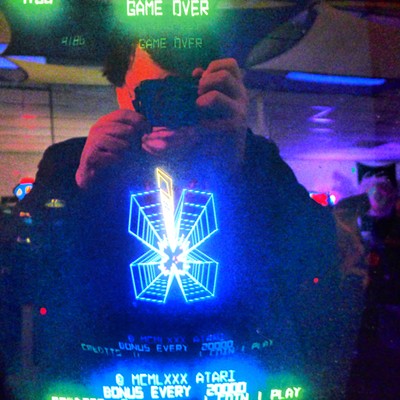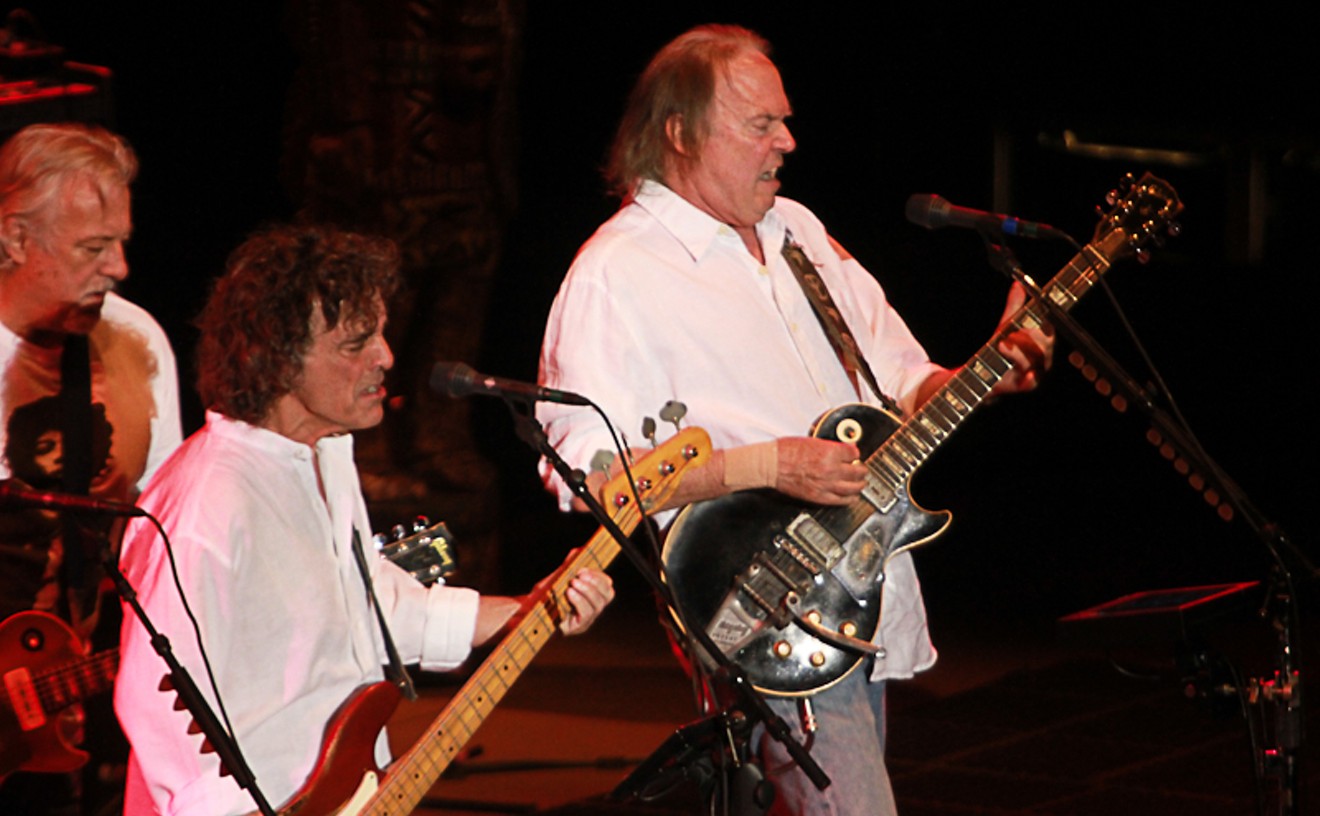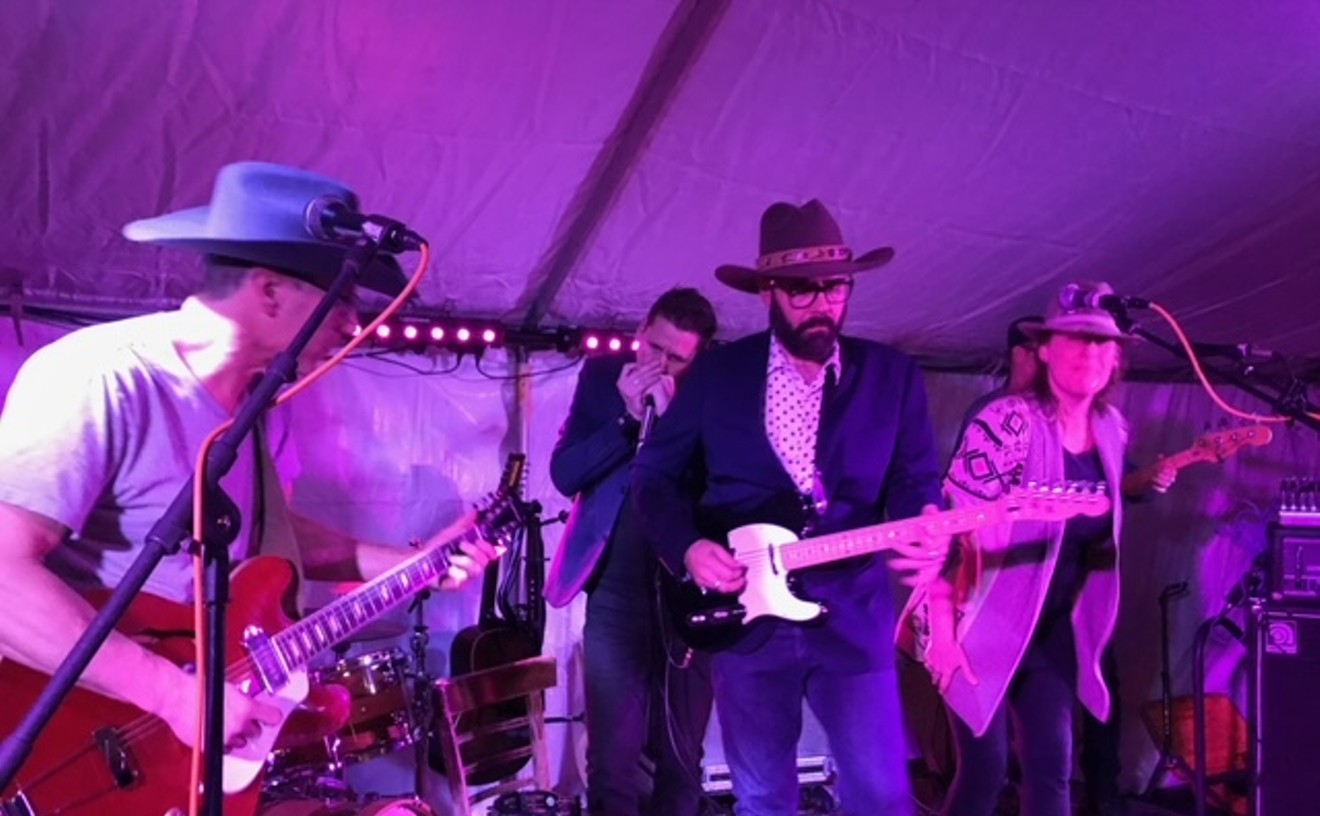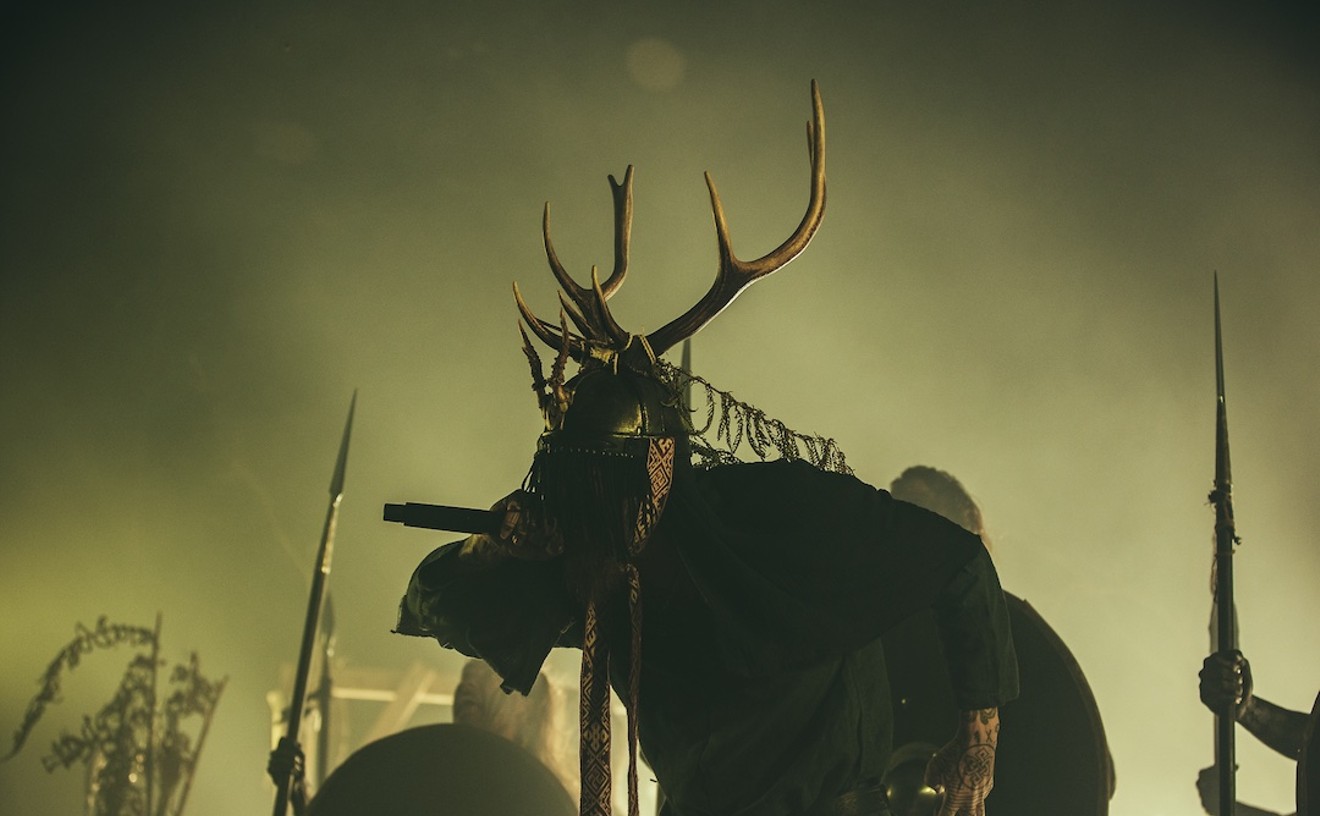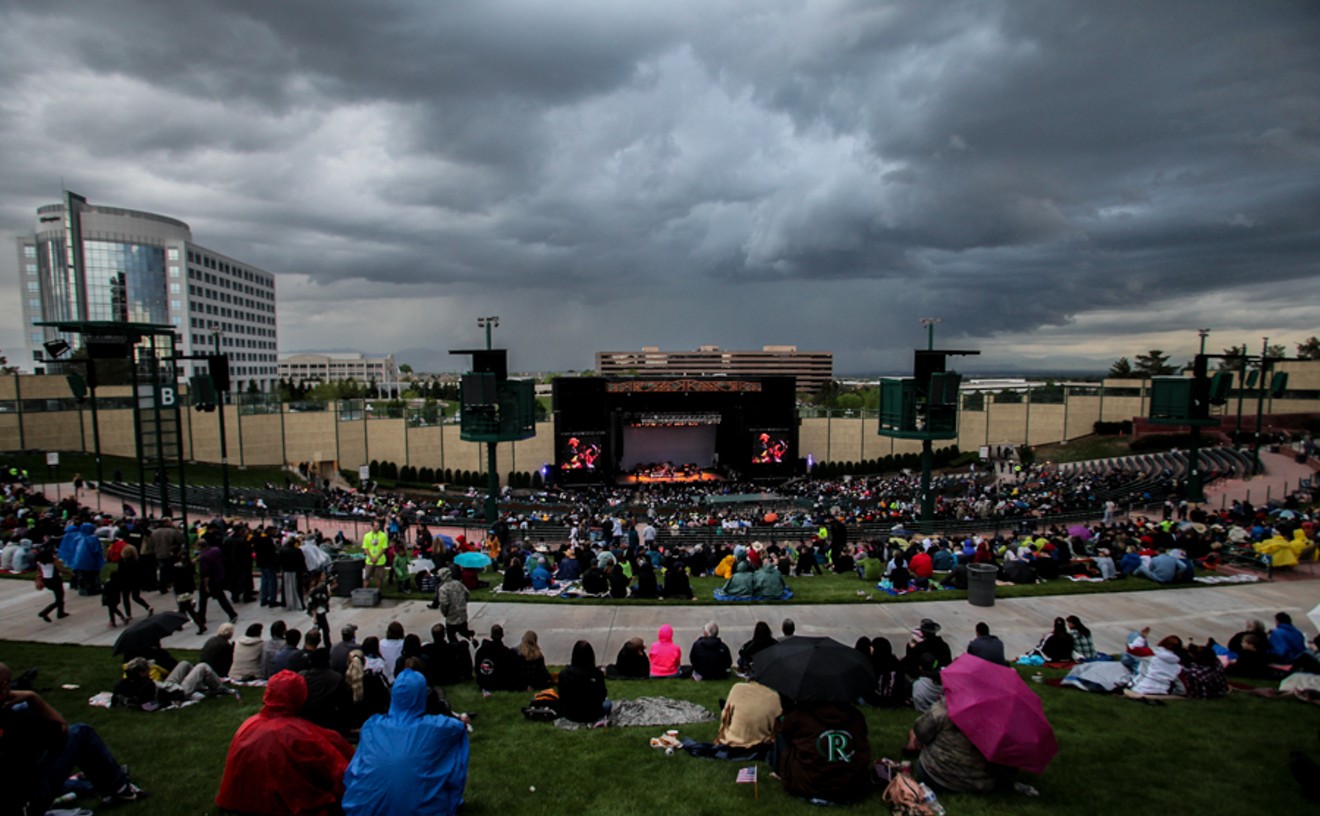During the late 1990s and early 2000s, Denver music was in a time of transition. It was the local cultural equivalent of the Dark Ages. But like the more well-known Dark Ages, there was plenty going on, including a vibrant punk scene and the indie-pop phenomenon pioneered by the Apples in Stereo and other bands involved in the Elephant 6 collective. A lot of the most interesting music was happening in warehouses and other DIY spaces, dive bars and house shows.
You had to find out about most of it by word of mouth, because most bands didn't have websites, there was no such thing as social media as we know it, and many of these bands didn't get much attention in the press.
These days, there are plenty of places for original bands to perform and be seen by people who might appreciate their music. What follows is part one of a two-part series featuring photographs of several of the bands that made up the underground music scene in Denver before it expanded to its current dimensions, and before pretty much any band could get press or airplay. (All or most of these photos were shot with a disposable camera, so the quality is very different from the pictures I shot on digital or with a better film camera later on.)Anne Frank on Crank was a punk band that won "Best Band Name" in the Onion. Fairly political but with a sense of humor, Anne Frank on Crank was a powerful live act reminiscent of Sleater-Kinney and Team Dresch.
Black Black Ocean was sort of a mathy emo band, but with an experimental edge. It quickly became one of the most popular underground bands in Denver, but split up by the middle of the decade. Stephen Till went on to form Nathan & Stephen/Hearts of Palm.
Catatonic Lydia was something of a riot grrrl-inspired punk band, but "punk" in the sense that, while it covered Bikini Kill live, the group was also influenced by Helium and PJ Harvey. The band existed from the late '90s to the summer of 2003. This is the third full incarnation of the band. Drummer Sophia Throop and bassist/singer Suzi Allegra went on to form the now-defunct My Sister Outlaw. Today Allegra plays bass and sings in Fingers of the Sun, Salad and Sunbeams, and Ancient Elk.
Danger Girl played in the same circles as Catatonic Lydia -- meaning whatever all-ages opportunities existed, including Cafe Euphrtates, house shows and coffee shops like Java Cow. Inspired in part by the MC5 and Mudhoney, Danger Girl, fronted by Max Bayers, wrote some surprisingly pop-inflected songs. In later years, Richard Castaldo joined the band on bass. You may know Castaldo from Michael Moore's Bowling for Columbine, when he and a friend went to K-Mart to try to return the bullets from inside his body that were purchased there by the Columbine Massacre shooters.
Esperanto was something of a space-rock band that included Wymond Miles of Pinkku and Ben DeSoto, who played with various other bands over the years and who would later book at the hi-dive and Lion's Lair. He now drums for Ark Life. Miles moved to San Francisco and joined the Fresh & Onlys and now also enjoys a critically acclaimed solo career.From Grand Junction, Love Letter Band created a bit of a stir in the underground for its heartfelt pop songs. Loosely part of the indie-pop phenomenon in Colorado and nationally, Love Letter Band was one of the main group of the later period of that first wave. Chris Adolf moved to Denver a couple of years later and kept the band name as a solo act before changing it to Bad Weather California. He now plays guitar and sings in American Culture.
Lovelife was a dark post-punk band from Baltimore reminiscent of The Birthday Party. Think something like a band that might have made music for the classic horror movie Carnival of Souls. Few people were at this show, and the stature of the band has since grown in circles of people into dark rock and Gothic rock. Singer Katrina Ford has contributed to several albums by other artists including TV on the Radio, Unkle and Future Islands. She also performs in the brighter, more tribal Celebration after the dissolution of Lovelife.
Mr. Pacman is a bit of a performance-art project/electro-pop band. At some point, frontman Avery Raines got ahold of the costume seen here. His bandmates wore similarly themed outfits. Also pictured is Toshimi Ichiki, the guitarist in the final incarnation of Rainbow Sugar.
Though not represented fully here, Otion was a band that wrote instrumental music clearly intended to accompany prepared videos. Most of its shows included this visual component, but at the performance pictured here, it was just the music. It's tempting to characterize it as post-rock, but the band was more like Scenic than Explosions in the Sky.
This is the first photo I shot of a band, and it shows. Rainbow Sugar was the band that got me into underground music in Denver. I'd seen 16 Horsepower in 1994 opening for the Violet Femmes and a handful of other bands that were good, like King Rat, Down N Outs and Seraphim Shock, but Rainbow Sugar was the band that made me sit up and entertain the possibility that other bands that weren't famous or being written about much by magazines or zines -- if at all -- could exist in Denver.
This is a better picture of Rainbow Sugar at the second location of Monkey Mania, when it moved downtown from the Baker District. Cindy Wonderful, Amy Fantastic and Germaine Baca were still in the band, but here the guitarist is Toshimi Ichiki rather than Michelle Olsen (who was in the previous picture).Regular was an excellent punk band that played at this early show at the Climax Lounge. On the left is bassist Mike Freeman. Freeman had played in Gina Go Faster, and that band's drummer used to say a Gina show wasn't complete until Freeman puked. He often did. Freeman was talented, and a nice guy, to boot. He passed away September 14, 2009, from brain cancer. I remember seeing him on stage on August 22, 2008, when NOFX brought him up to make a statement against cancer, and hoping I'd get to see him play again. Unfortunately, none of us did.
Sin Desires Marie was like Denver's Mission of Burma. Its raw, experimental kind of post-punk was always inspirational to see. Germaine Baca of Rainbow Sugar also played drums in this band. Bassist Yoon Park, a teacher at George Washington High School, taught members of Fissure Mystic, who had no idea she was a musician until years later. Claudine Rousseau had a primal power as a guitarist and vocalist that was incredibly cathartic. The whole band had that effect. SDM reunited in 2011 for a handful of shows. Both Rousseau and Park are members of the BIg Get Even. Baca played for a while with Old Time Relijun.
Space Team Electra was a space-rock band, as might be gleaned from the name, but the name also came from the Eugene O'Neill play Mourning Becomes Electra. Part space rock, part psychedelic and literary in its songwriting, the band was also one of the most popular groups in the Denver underground. It recorded its debut album, 1998's The Vortex Flower, with Keith Cleversley and its final full-length, 2002's The Intergalactic Torch Song, with legendary producer Sandy Pearlman. I personally tried to see them at every opportunity after first seeing the band in April 1999 at the Bluebird Theater.
Sparkles was a noise-rock band for a few years. It played with such forcefulness and ferocity that guitarist and singer Luke Fairchild would fall off the stage backward, bound up and get back up to do the same. Former Felt Pilotes, Koala and North Americans bassist/guitarist Doug Mioducki was the other co-lead vocalist. Fairchild went on to future recognition in bands like White Dynamite, Kingdom of Magic, Git Some and Mako 1972.
Until the band broke up, around 2008, Tarmints was one of the most impressive live rock acts in Denver. Fronted by Kurt Ottaway, who had established himself as a bit of a legendary figure for his time in Twice Wilted and for establishing various warehouse venues from the 80s through the early 2000s, Tarmints were like the Birthday Party, Gun Club and Killing Joke in some ways, but completely informed by the aesthetic of Cormac McCarthy's writing. Ottaway's image adorns the top of the article when he somehow hopped up on the overhang of the stage at the Climax Lounge. Pictured here left to right are Bobby Jamison, AJ Hatthaway and Sarah Goodroad.The Bedraggled was a dark post-punk band that Reverend Dead Eye used to front. His time under that moniker overlaps with this band by a year or two. Bassist Adam Avery went on to play in Ill Gotten Gainz. Drummer BJ Serekis later played in The Skivies for a couple of years or so. Violinist Natasha "Maia" Fortis now plays in a project with former Phantom Trigger/Hexen guitarist Brian Fawcett.
The Czars certainly got a bit of international fame. The dream-pop band was one of the bright lights of underground rock in Denver in the '90s, though sometimes their live shows could be a bit sedate. The act warmed up a bit in the early 2000s, and it released a few records on Simon Raymonde's Bella Union imprint. John Grant has since gone on to a very successful solo career. Andy Monley and Chris Pearson had played in Jux Country before this band and have since gone back to that project. Roger Green's solo career is so varied and consistently interesting that it would be difficult to categorize but not to recommend. Drummer Jeff Linsenmaier played with the Fray for a bit, but has also gone on to play in Dust on the Breakers.
The GEDs included former Twice Wilted, '57 Lesbian and Spell bassist and singer Chanin Floyd. Musically, a lot like the post-punk end of grunge, it sounded more like it came out of heavier garage punk before that came back into vogue. Rumor has it that the GEDs are working on their debut full-length album. Finally.
The Lavellas wre a shoegaze/dream-pop band started by Roger Green's little brother, Robert Green. Inspired by seeing Space Team Electra in 1994 when it was still called Dive, Robert wrote some really emotionally stirring pop songs in the shoegaze vein. The project played often throughout the early 2000s before moving to Chicago. Green now lives in Barcelona.
The Maybellines were one of the most important of the later-period indie-pop bands from that first wave. There was a brightness and innocence to the band's sound, and its subject matter was the perfect counter vibe to some of the gritty dive bars and warehouses the band often played. The liner notes for its final full-length album, Chatfield Holiday, were written by longtime Westword scribe and renowned science-fiction writer Jason Heller.The Speedholes were one of the many punk bands that regularly performed at 15th St. Tavern. Dan Merrick was a medical doctor at the time, so who knows how he had the time to be in an active band, but he did it. He and bassist Kelly Knudsen are now married. For a while, Joe Henry, formerly of the Rok Tots and now of the Buckingham Squares, was in this band. Pictured here at a rare rock show at the Denver Zen Center (I asked my friend Rebecca Bauer to shoot some pictures, as she is a real photographer and had a good camera) is guitar wizard Sara Fischer, playing with this band for that short tenure. The Merricks aren't really in a band now. Fischer plays solo as Sarabelle and sometimes with her garage punk/pop band Bluebelle.
Uphollow got a start early when Ian O'Dougherty was still in his early teens. It evolved over the years and experimented with different styles of music in phases. But in 2002 it was more like a chamber pop band before that really became a going concern and did it better than most. It didn't hurt that Ian Cooke (on the right) was in the band at that time. O'Dougherty now plays in the Ian Cooke band as well as Eolian, Taun Taun and, of course, sometimes Uphollow.
What Tribe? was an excellent, experimental pop band fronted by Raj Chaudhari. Should have been bigger because Chaudhari's songwriting was top notch and he had a great ear for catchy melodies. The name came about because when Chaudhari was growing up he'd tell people he was Indian and really dumb people with no knowledge of the world or history would ask him, yes, "What tribe?" Chaudhari still lurks around in this side of Colorado and occasionally pops out of the woodwork but not with a live band that tried to play shows and promote itself a little.
Worm Trouble was what might have been called an alternative rock band when it formed in the mid-1990s. Its eclectic songwriting reflected the very different styles of its primary writers, married couple Kathryn Ellinger and Michael Trenhaile. But this band never shared any duds or failed experiments with us and seemed to have great songs every show. It eventually changed its name to The Sleepers when the couple split its songwriting efforts into two projects with The Sleepers being Ellinger''s songs and The Absolute Zero being those of Trenhaile. Ellinger is now continuing with The Sleepers and has had a comeback in the last two years while Trenhaile has moved back to his home state of Nebraska and occasionally gigs.
*Author's Note on the High Plains Underground Archive: In the late 1990s, I started going to local shows on a regular basis. Growing up in the '70s and '80s, I didn't know there was such a thing as local music worth checking out.
But I was drawn in after seeing a band called Rainbow Sugar (an all-female punk/hip-hop/experimental guitar rock extravaganza) opening for Sleater-Kinney's first show in Colorado at The Fox Theatre in October 1998. Next, I learned about a show at the now-defunct Rebis Galleries. From there I went to the first Monkey Mania show, and there was no looking back.
Rainbow Sugar was the first local band I photographed at Herman's Hideaway in 1999. But it was in 2005 when I got my first digital camera that my extensive photo archive started. In this series, called High Plains Underground Archive, I will share a small fraction of the tens of thousands of those photos, focusing on specific venues, bands, time periods, movements and whatever else seems to make sense. The title of this series comes from the working title of my book on the history of underground music in Denver 1975 to the present.
• BACKBEAT'S GREATEST HITS • - Seven of Denver's Most Underrated Bands - You'll Never See Another Show Like The One Chimney Choir Has Planned - Why DIY Venues Are Vital Are Vital to the Health of the Entire Music Scene - DIY or Die: Why Denver Need Under-The_Radar, All-Ages Arts Spaces
Follow @Westword_Music
If you'd like to contact me, Tom Murphy, on Twitter, my handle is @simianthinker.


